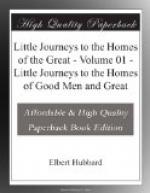It costs a shilling to visit the castle. A fine old soldier in spotless uniform, with waxed white moustache and dangling sword, conducts the visitors. He imparts full two shillings’ worth of facts as we go, all with a fierce roll of r’s, as becomes a man of war.
The long line of battlements, the massive buttresses, the angular entrance cut through solid rock, crooked, abrupt, with places where fighting men can lie in ambush, all is as Shakespeare knew it.
There are the cedars of Lebanon, brought by Crusaders from the East, and the screaming peacocks in the paved courtway: and in the Great Hall are to be seen the sword and accouterments of the fabled Guy, the mace of the “Kingmaker,” the helmet of Cromwell, and the armor of Lord Brooke, killed at Litchfield.
And that Shakespeare saw these things there is no doubt. But he saw them as a countryman who came on certain fete-days, and stared with open mouth. We know this, because he has covered all with the glamour of his rich, boyish imagination that failed to perceive the cruel mockery of such selfish pageantry. Had his view been from the inside he would not have made his kings noble nor his princes generous; for the stress of strife would have stilled his laughter, and from his brain the dazzling pictures would have fled. Yet his fancies serve us better than the facts.
Shakespeare shows us many castles, but they are always different views of Warwick or Kenilworth. When he pictures Macbeth’s castle he has Warwick in his inward eye:
“This castle hath a
pleasant seat: the air
Nimbly and sweetly recommends
itself
Unto our gentle senses.
This guest of Summer,
The temple-haunting martlet,
does approve,
By his loved mansionry, that
the heaven’s breath
Smells wooingly here:
no jutty, frieze,
Buttress, nor coign of vantage,
but this bird
Hath made his pendent bed,
and procreant cradle;
Where they most breed and
haunt, I have observed,
The air is delicate.”
Five miles from Warwick (ten, if you believe the cab-drivers) are the ruins of Kenilworth Castle.
In Fifteen Hundred Seventy-five, when Shakespeare was eleven years of age, Queen Elizabeth came to Kenilworth. Whether her ticket was by way of Leamington I do not know. But she remained from July Ninth to July Twenty-seventh, and there were great doings ’most every day, to which the yeomanry were oft invited. John Shakespeare was a worthy citizen of Warwickshire, and it is very probable that he received an invitation, and that he drove over with Mary Arden, his wife, sitting on the front seat holding the baby, and all the other seven children sitting on the straw behind. And we may be sure that the eldest boy in that brood never forgot the day. In fact, in “Midsummer Night’s Dream” he has called on his memory for certain features of the show. Elizabeth was forty-one years old then, but apparently very attractive and glib of tongue. No doubt Kenilworth was stupendous in its magnificence, and it will pay you to take down from its shelf Sir Walter’s novel and read about it. But today it is all a crumbling heap; ivy, rooks and daws hold the place in fee, each pushing hard for sole possession.




